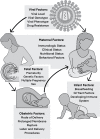Understanding Viral and Immune Interplay During Vertical Transmission of HIV: Implications for Cure
- PMID: 34745130
- PMCID: PMC8566974
- DOI: 10.3389/fimmu.2021.757400
Understanding Viral and Immune Interplay During Vertical Transmission of HIV: Implications for Cure
Abstract
Despite the significant progress that has been made to eliminate vertical HIV infection, more than 150,000 children were infected with HIV in 2019, emphasizing the continued need for sustainable HIV treatment strategies and ideally a cure for children. Mother-to-child-transmission (MTCT) remains the most important route of pediatric HIV acquisition and, in absence of prevention measures, transmission rates range from 15% to 45% via three distinct routes: in utero, intrapartum, and in the postnatal period through breastfeeding. The exact mechanisms and biological basis of these different routes of transmission are not yet fully understood. Some infants escape infection despite significant virus exposure, while others do not, suggesting possible maternal or fetal immune protective factors including the presence of HIV-specific antibodies. Here we summarize the unique aspects of HIV MTCT including the immunopathogenesis of the different routes of transmission, and how transmission in the antenatal or postnatal periods may affect early life immune responses and HIV persistence. A more refined understanding of the complex interaction between viral, maternal, and fetal/infant factors may enhance the pursuit of strategies to achieve an HIV cure for pediatric populations.
Keywords: HIV; MTCT; antiretroviral; breast milk; cure; pediatric; reservoir; shock and kill.
Copyright © 2021 Amin, Powers, Bricker and Chahroudi.
Conflict of interest statement
The authors declare that the research was conducted in the absence of any commercial or financial relationships that could be construed as a potential conflict of interest.
Figures
References
-
- Centers for Disease C. Unexplained Immunodeficiency and Opportunistic Infections in Infants–New York, New Jersey, California. MMWR Morb Mortal Wkly Rep (1982) 31(49):665–7. - PubMed
-
- UNAIDS . Global HIV & AIDS Statistics - Fact Sheet. UNAIDS; (2011). Available at: https://www.unaids.org/en/resources/fact-sheet (Accessed 10/06/2020).
-
- WHO . Antiretroviral Drugs for Treatment Pregnant Women and Preventing HIV Infection in Infants: Recommendations for a Public Health Approach. Geneva: WHO; (2010). - PubMed
-
- HIV/AIDS) UJUNPo . Press Release: “World Leaders Launch Plan to Eliminate New HIV Infections Among Children by 2015”. Geneva: UNAIDS; (2011).
-
- UNAIDS . Global HIV & AIDS Statistics. UNAIDS; (2020).
Publication types
MeSH terms
Substances
Grants and funding
LinkOut - more resources
Full Text Sources
Medical



